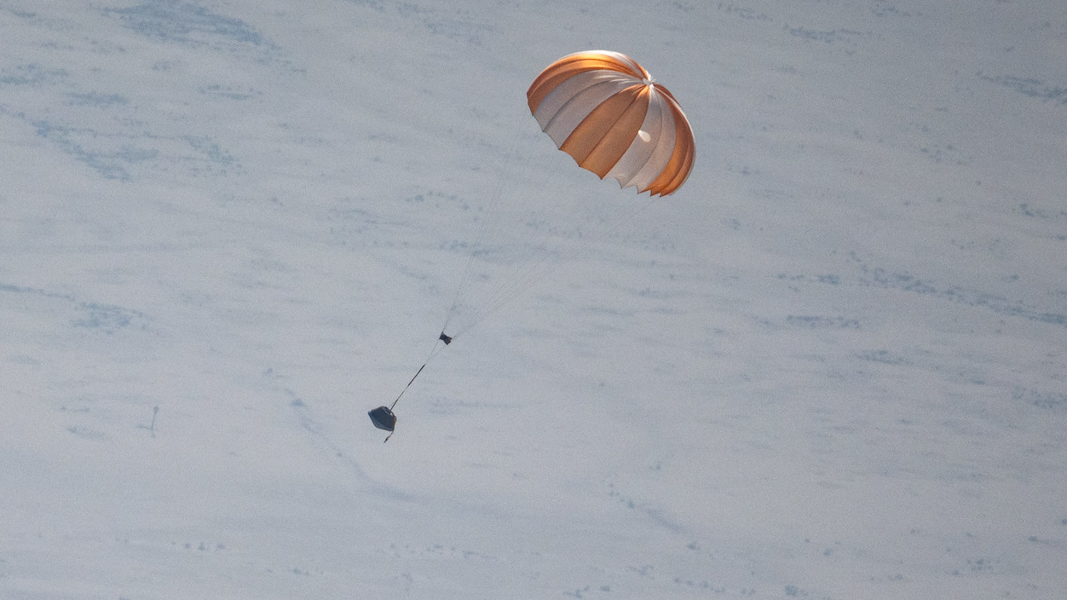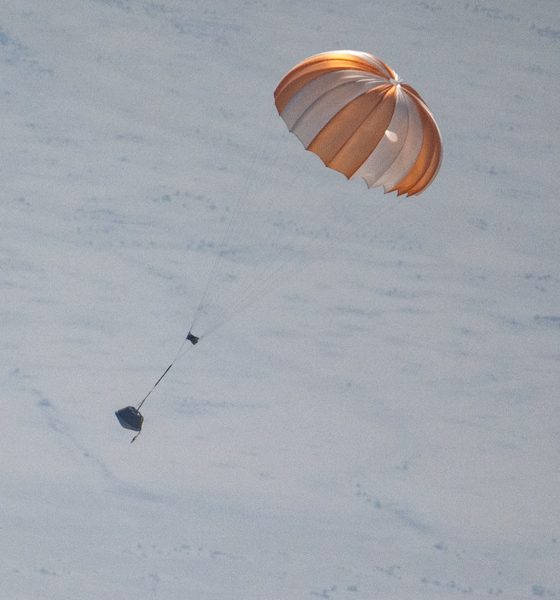

News
NASA prepares for the return of the Osiris-Rex asteroid sample mission
The OSIRIS-REx mission is nearing its final stretch as it closes in on Earth after a seven-year round trip to the asteroid Bennu. The capsule containing the sample is scheduled the make the fiery plunge through the atmosphere on September 24th.
The mission, Origins, Spectral Interpretation, Resource Identification, Security-Regolith Explorer, launched back in September 2016 atop a United Launch Alliance Atlas V to begin its journey to the near-Earth asteroid and after a 2-year trip through space arrived in orbit around Bennu in December 2018.
The orbiter proceeded to study the asteroid for nearly 2 more years, searching for a proper site to conduct its touch-and-go landing in order to collect a viable sample of the asteroid. After a thorough scan of the celestial body, sometimes orbiting less than a mile above the surface, NASA selected its location and commanded the orbiter to lower itself to the surface for the sample.
Well, I definitely touched down on Bennu!
Preliminary data show the sampling head touched Bennu’s surface for approximately 6 seconds, within 3 feet (1 meter) of the targeted location. #ToBennuAndBack
More details: https://t.co/4rBrB27FEZ pic.twitter.com/LjDQICmxJM
— NASA’s OSIRIS-REx (@OSIRISREx) October 21, 2020
The goal of the mission was to collect 2.1 ounces of regolith. After the maneuver was completed, the orbiter backed away from Bennu with its sample. It wasn’t smooth sailing, though, as the lid for the sample tube did not have a perfect seal and was leaking back out into space. When mission controllers saw this, they commanded the spacecraft to store the tube in the Sample Return Capsule.
At first, the teams did not know if they managed to get the 2.1-ounce sample, but after measurements, they determined they had at least 8.1 ounces of regolith from Bennu, according to Dante Lauretta, OSIRIS-REx principal investigator from the University of Arizona, Tucson.
Once the sample was confirmed to be secured in the capsule, OSIRIS-REx left the orbit of Bennu in May 2021 for its trip back to Earth.
Back on the ground in Utah, recovery teams have now run multiple test runs of recovery day, including multiple drop simulations from an aircraft and practicing to make sure the sample is handled carefully and not contaminated after landing.
Teams will conduct a go/no go poll prior to the Sample Return Capsules release from the orbiter, and if for some reason a no is given, they won’t have a chance to recover the sample until 2025 after a risky trip near the Sun.
Once a go is given, the capsule will be released from the orbiter 4 hours before the scheduled re-entry. The capsule will hit the atmosphere at 27,000 miles per hour, followed by a parachute being deployed and a soft touchdown at 10 miles per hour. The orbiter will perform a maneuver after release so it doesn’t enter the atmosphere and will undertake a brand new mission to study the asteroid Apophis.
Scientists hope to get a better understanding of how the Earth and Solar System formed, and a successful sample return will produce a ton of exciting discoveries.
Questions or comments? Shoot me an email at rangle@teslarati.com, or Tweet me @RDAnglePhoto.

News
Tesla FSD fleet is nearing 7 billion total miles, including 2.5 billion city miles
As can be seen on Tesla’s official FSD webpage, vehicles equipped with the system have now navigated over 6.99 billion miles.

Tesla’s Full Self-Driving (Supervised) fleet is closing in on almost 7 billion total miles driven, as per data posted by the company on its official FSD webpage.
These figures hint at the massive scale of data fueling Tesla’s rapid FSD improvements, which have been quite notable as of late.
FSD mileage milestones
As can be seen on Tesla’s official FSD webpage, vehicles equipped with the system have now navigated over 6.99 billion miles. Tesla owner and avid FSD tester Whole Mars Catalog also shared a screenshot indicating that from the nearly 7 billion miles traveled by the FSD fleet, more than 2.5 billion miles were driven inside cities.
City miles are particularly valuable for complex urban scenarios like unprotected turns, pedestrian interactions, and traffic lights. This is also the difference-maker for FSD, as only complex solutions, such as Waymo’s self-driving taxis, operate similarly on inner-city streets. And even then, incidents such as the San Francisco blackouts have proven challenging for sensor-rich vehicles like Waymos.
Tesla’s data edge
Tesla has a number of advantages in the autonomous vehicle sector, one of which is the size of its fleet and the number of vehicles training FSD on real-world roads. Tesla’s nearly 7 billion FSD miles then allow the company to roll out updates that make its vehicles behave like they are being driven by experienced drivers, even if they are operating on their own.
So notable are Tesla’s improvements to FSD that NVIDIA Director of Robotics Jim Fan, after experiencing FSD v14, noted that the system is the first AI that passes what he described as a “Physical Turing Test.”
“Despite knowing exactly how robot learning works, I still find it magical watching the steering wheel turn by itself. First it feels surreal, next it becomes routine. Then, like the smartphone, taking it away actively hurts. This is how humanity gets rewired and glued to god-like technologies,” Fan wrote in a post on X.
News
Tesla starts showing how FSD will change lives in Europe
Local officials tested the system on narrow country roads and were impressed by FSD’s smooth, human-like driving, with some calling the service a game-changer for everyday life in areas that are far from urban centers.

Tesla has launched Europe’s first public shuttle service using Full Self-Driving (Supervised) in the rural Eifelkreis Bitburg-Prüm region of Germany, demonstrating how the technology can restore independence and mobility for people who struggle with limited transport options.
Local officials tested the system on narrow country roads and were impressed by FSD’s smooth, human-like driving, with some calling the service a game-changer for everyday life in areas that are far from urban centers.
Officials see real impact on rural residents
Arzfeld Mayor Johannes Kuhl and District Administrator Andreas Kruppert personally tested the Tesla shuttle service. This allowed them to see just how well FSD navigated winding lanes and rural roads confidently. Kruppert said, “Autonomous driving sounds like science fiction to many, but we simply see here that it works totally well in rural regions too.” Kuhl, for his part, also noted that FSD “feels like a very experienced driver.”
The pilot complements the area’s “Citizen Bus” program, which provides on-demand rides for elderly residents who can no longer drive themselves. Tesla Europe shared a video of a demonstration of the service, highlighting how FSD gives people their freedom back, even in places where public transport is not as prevalent.
What the Ministry for Economic Affairs and Transport says
Rhineland-Palatinate’s Minister Daniela Schmitt supported the project, praising the collaboration that made this “first of its kind in Europe” possible. As per the ministry, the rural rollout for the service shows FSD’s potential beyond major cities, and it delivers tangible benefits like grocery runs, doctor visits, and social connections for isolated residents.
“Reliable and flexible mobility is especially vital in rural areas. With the launch of a shuttle service using self-driving vehicles (FSD supervised) by Tesla in the Eifelkreis Bitburg-Prüm, an innovative pilot project is now getting underway that complements local community bus services. It is the first project of its kind in Europe.
“The result is a real gain for rural mobility: greater accessibility, more flexibility and tangible benefits for everyday life. A strong signal for innovation, cooperation and future-oriented mobility beyond urban centers,” the ministry wrote in a LinkedIn post.
News
Tesla China quietly posts Robotaxi-related job listing
Tesla China is currently seeking a Low Voltage Electrical Engineer to work on circuit board design for the company’s autonomous vehicles.

Tesla has posted a new job listing in Shanghai explicitly tied to its Robotaxi program, fueling speculation that the company is preparing to launch its dedicated autonomous ride-hailing service in China.
As noted in the listing, Tesla China is currently seeking a Low Voltage Electrical Engineer to work on circuit board design for the company’s autonomous vehicles.
Robotaxi-specific role
The listing, which was shared on social media platform X by industry watcher @tslaming, suggested that Tesla China is looking to fill the role urgently. The job listing itself specifically mentions that the person hired for the role will be working on the Low Voltage Hardware team, which would design the circuit boards that would serve as the nervous system of the Robotaxi.
Key tasks for the role, as indicated in the job listing, include collaboration with PCB layout, firmware, mechanical, program management, and validation teams, among other responsibilities. The role is based in Shanghai.
China Robotaxi launch
China represents a massive potential market for robotaxis, with its dense urban centers and supportive policies in select cities. Tesla has limited permission to roll out FSD in the country, though despite this, its vehicles have been hailed as among the best in the market when it comes to autonomous features. So far, at least, it appears that China supports Tesla’s FSD and Robotaxi rollout.
This was hinted at in November, when Tesla brought the Cybercab to the 8th China International Import Expo (CIIE) in Shanghai, marking the first time that the autonomous two-seater was brought to the Asia-Pacific region. The vehicle, despite not having a release date in China, received a significant amount of interest among the event’s attendees.








